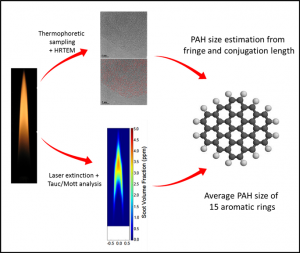Maria Botero, Erin M. Adkins, Silvia Gonzalez Calera, Houston Miller, and Markus Kraft
Combustion and Flame 164, 250-258, (2016)
Soot particles formed in a system of non-premixed liquid fuel flames supported on a wick-fed, smoke point test burner (ASTM D1322-08) were characterised by in-situ visible light extinction and thermophoretically-sampled high-resolution transmission electron microscopy measurements, HRTEM. The fuels studied were heptane, toluene and their iso-volumetric mixture (H50T50), given their relevance as surrogate fuels. Extinction measurements were used to calculate the soot volume fraction, Fv, and determine the optical band gap (OBG) as a function of flame position. The OBG was derived from the near-edge absorption feature using Tauc/Davis-Mott analysis. For the HRTEM analysis, soot samples were collected at different locations in the flame using thermophoretic sampling and a fast-insertion technique. The images were then analysed using a `lattice-fringe' algorithm, to determine important parameters such as the fringe length. Polycyclic aromatic hydrocarbon (PAH) sizes were estimated from conjugation length obtained from OBG measurements and fringe lengths from HRTEM measurements. Across all studied flames, the peak Fv ranged from 3.8 ppm in the heptane flame to 18.0 ppm in the toluene flame. Despite this wide range, the average OBG across the different flames only varied from 1.99 eV in the H50T50 to 2.06 eV in the heptane flames, which is consistent with molecule lengths of between 0.98 nm and 1.02 nm. Lattice fringe analysis yielded slightly lower average fringe lengths between 0.85 - 0.96 nm throughout the different flames. This work provides experimental support to the model of soot formation where the transition from chemical to physical growth starts at a modest molecular size; about the size of circumpyrene.

